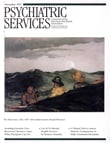Effect of antidepressant therapy on health care utilization and costs in primary care
Abstract
OBJECTIVE: Four groups of patients receiving different antidepressant drugs in a primary care setting were compared in terms of duration of antidepressant therapy and health and mental health care utilization and costs. METHODS: A retrospective analysis of the medical and pharmacy claims of an employed population and their families was conducted. A total of 1,242 patients with a diagnosis of depression were included in the analyses. The four antidepressant cohorts were fluoxetine (N = 799), trazodone (N = 89), the tricyclics amitriptyline and imipramine (N = 104), and the secondary amine tricyclics desipramine and nortriptyline (N = 250). The primary outcome measures were total health care charges, total charges for mental health services, and the pattern of antidepressant use. Secondary measures included charges for outpatient care and pharmacy and the number of outpatient visits. Data analysis involved use of two-stage multivariate regression modeling known as sample selection models. RESULTS: Patients taking fluoxetine achieved higher rates of continuous use for at least six months compared with those taking the other drugs. After selection bias due to observed and unobserved characteristics and other confounding variables was adjusted for, no significant differences were found between drug cohorts in total medical charges. CONCLUSIONS: Improvements in the process of care at no apparent increase in total charges appear possible through appropriate medication therapy.



